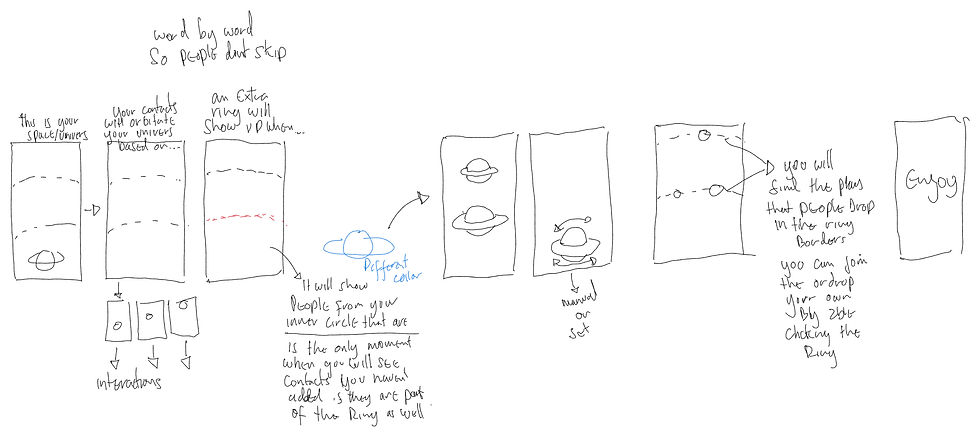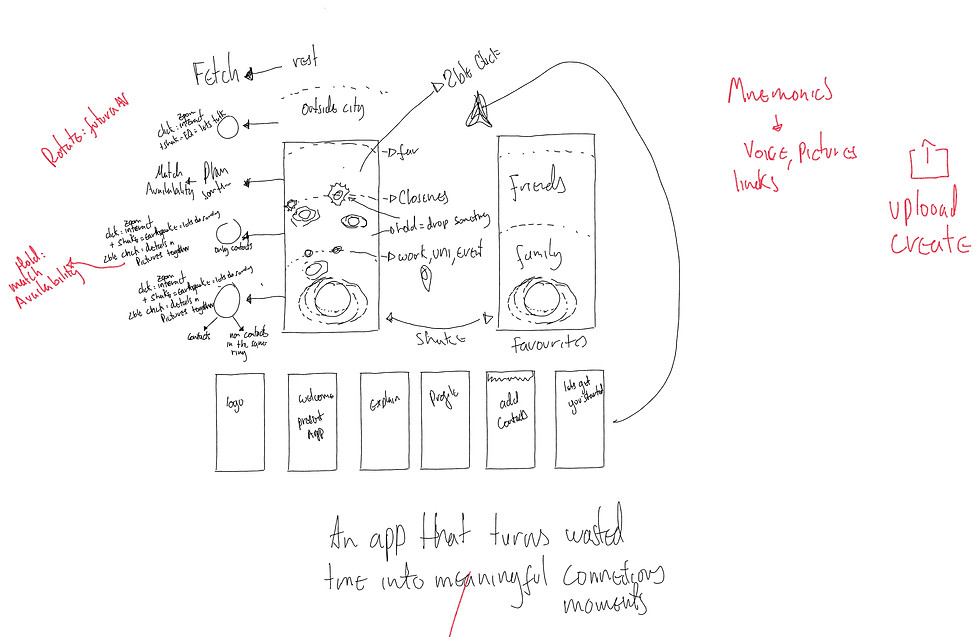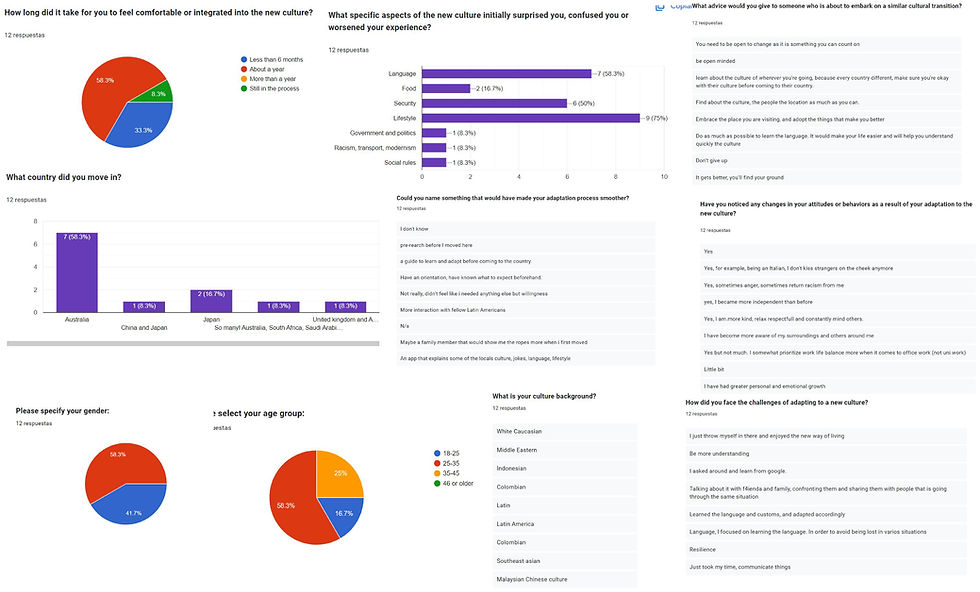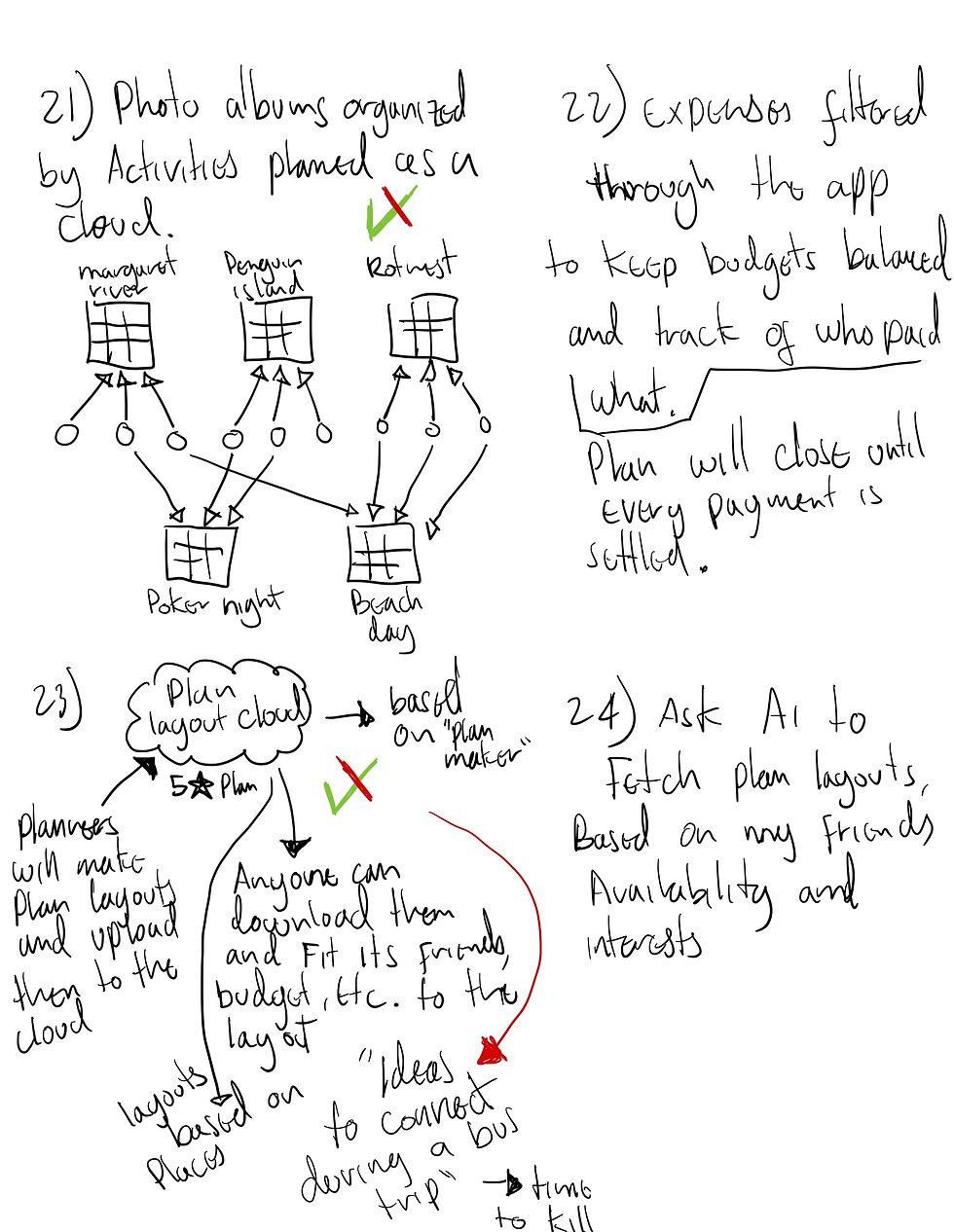
SIZIGI

UX/UI & Branding

SIZIGI is a social media app that, through its innovative interface, creates and discovers opportunities to cultivate old and new friendships in the real world, based on availability and location.
MAY OUR LIVES ALIGIN


UX/UI & Branding
SIZIGI
The social media that trully connects people.
SIZIGI
UX/UI and Branding
SIZIGI is a social media app that creates and finds opportunities to cultivate old and new friendships in the real world, based on availability and location.
By organizing your friend's contacts based on availability and location, Sizigi’s interface can show you in real time when it is the best moment to meet a friend. What is more, the app dynamics and tools are designed to make these spontaneous meetings feel organic and effortless.
The main tasks to design SIZIGI were deep research to succesfully adress the user needs, design a revolutionary method to organize contacts that led to actually interact with them, and as a final touch, brand and design the interface accordingly.
2024
By Santiago Viveros
Want to see the full design process? Switch to the desktop version for the best experience.
THE SIZIGI EXPERIENCE
Carefully designed to make meaningful opportunities visible and reachable.
The SIZIGI experience prototype was designed and displayed for exhibition purposes, it is presented as an introductory experience and a process log.
Begin tour
Allow the SIZIGI app to guide you through the experience that this innovative interface brings.
Skip tour



Skip the tour and jump straight to the action. Only recomended if you already toured the protype once.
Behind the scenes
Let me tell you a little bit about the design process and my personal journey during this project.
Carefully designed to make meaningful opportunities visible and reachable.
THE SIZIGI EXPERIENCE



The SIZIGI experience prototype was designed and displayed for exhibition purposes, it is presented as an introductory experience and a process log.
"How can contemporary mobile technologies help immigrants improve the quality of their personal bonds with family and friends by leveraging reduced time off periods?"
Research question:
The brief:
Many migrants challenges that contrubute to culture shock, impacting mental health. How can I make these challenges more bearable with practical, innovative solutions to improve immigrant experiences.

Framework:
.jpg)
Research showed immigrants often misjudge their availability, despite wanting to connect. Though family and friends are key to well-being, time often goes unused unless socializing is effortless, leading many to default to passive activities like TikTok instead of meaningful interactions.
I designed a social media app to help users visualize their free time and align it with friends’ schedules.
Design Proposition
Prototypes










Sketches
Figjam wireframe
Features wireframe




Exposition
Introduction
The Brief
Discover
Define
Ideate
Prototype
Many people migrate for work, study, or safety, but often face strict visa rules, unstable jobs, and no guarantee of residency; factors that can lead to stress and poor mental health. Adapting to a new country also brings loneliness, homesickness, and culture shock, making the experience even harder. While social connections can help, these struggles are complex and deeply personal, making them a “wicked problem” with no simple fix.
In early 2024, over 57,000 international students were in Western Australia, many likely experiencing these challenges. During the BeCome project, culture shock emerged as a key issue, but its complexity required narrowing the focus. The SIZIGI project therefore aimed to create practical, innovative solutions—not to erase culture shock entirely, but to reduce its impact and improve the immigrant experience.
Culture shock affects immigrants, international students, refugees, and even those facing major changes within their own societies. It can arise from cultural differences, lack of preparation, limited social support, and individual psychological traits. Winkelman (1994) defines it as stemming from cognitive overload and behavioral inadequacies, best managed through social learning, adapting attitudes and behaviors to new environments.
Its impacts are wide-ranging: stress that weakens immunity, cognitive fatigue from processing constant unfamiliar information, and role shock, where the loss of familiar social roles creates identity confusion and emotional strain. Together, these highlight the complex psychological, social, and physiological challenges of cultural transition.
Culture shock
Surveys
Building on key research around culture shock, I conducted quantitative research to explore how individuals experience and manage adaptation. The questionnaire was shared mainly with international students from diverse backgrounds in Western Australia, with some responses also coming from students abroad.

Immigrants often strive to build a lifestyle similar to, or better than, the one they had. However, realizing that this may not happen, or not in the expected way, can generate discomfort and frustration.
Conducting this survey allowed me to understand, among other things, that the main challenges international students in Western Australia face include being far from family and friends and feeling disconnected from their new environment, factors that often lead to a strong sense of loneliness.
Interviews
In response to insights from my earlier research, I initially designed Become, a mixed reality (MR) app that helped users explore new environments in a personalized way, aiming to make life in a foreign country more appealing and manageable.
When I revisited the project, I realized a crucial element was missing. Rather than continuing from where I left off, I stepped back to reassess what was lacking.
Instead of assuming migrants simply needed tools to explore the city and meet companions, I conducted more personal conversations to understand why they weren’t discovering the city organically. These interviews also helped me evaluate how relevant my previous design truly was to their needs.
I spoke with six immigrants working across different sectors, some newly arrived students, others long-term residents living under various visa conditions.
Yugansh
Yugansh studied and worked for many years. Now that he has completed his studies, he has more free time to go out. However, he regrets not being more socially active during the limited free time he had while studying.
Tuco
Tuco shared that his main challenge is balancing a lack of time with a limited budget. Occasionally, he goes out for a beer with colleagues after work, usually to the same place where they receive discounts and the timing is convenient. If a plan doesn’t feel entirely comfortable or convenient, he prefers not to go out at all.
Thomas
Thomas works overnight shifts because no one else wants them. While he appreciates the stability this provides, his social life has been greatly affected, as his schedule and energy levels no longer align with those of his colleagues and housemates.
Christian is a FIFO (Fly-In Fly-Out) worker who loves Perth. While he enjoys the city, he struggles to make the most of his time off from the mines. He usually spends this time with his partner, as he finds it inconvenient and cumbersome to coordinate with friends whenever he returns.
Christian
Juliana
Juliana has a stable social life that revolves around a close-knit group of people. She is completely satisfied with her social life in terms of entertainment. However, she would appreciate the opportunity to make new contacts related to the professional field she hopes to work in.
Dominika
Dominika is a backpacker who has spent several years in Australia. She has a wide social network and enjoys an active social life. However, managing her time and staying in touch with everyone can be challenging. She sometimes misses plans or opportunities to meet friends because she doesn’t know when they will be in the city.
State of art
_page-0001.jpg)
Super apps
Artificial intelligence
Data collection
Persistent ubiquitous experience
Super apps are mobile applications that combine a wide variety of technological services and features into a single platform. Popular mainly in Asia, these apps allow users to multitask without switching between different applications. Common features include messaging, shopping, booking services, payments, and more. In most cases, super apps integrate third-party services to enhance functionality and centralize user data within one ecosystem.
Artificial intelligence (AI) refers to computer systems or software that replicate human reasoning and problem-solving abilities. These technologies are powered by databases and operate through a process called machine learning, enabling them to simulate human understanding and perform tasks such as language processing, pattern recognition, and decision-making.
The first stage of machine learning involves providing coded language that corresponds to human knowledge. The system learns to associate code patterns with concepts and context, effectively translating human requests into programmatic instructions. AI does not inherently understand images or make graphical and sensory associations in the way humans do. Instead, it organizes code into specific units called “tokens,” which are then translated into words.
In the second stage, AI improves its performance by continuously interacting with humans and analyzing how we typically associate and use those tokens (Gentile, 2023).
Data collection involves systematically gathering insights about user behavior to support better decision-making and improve user experiences. Typically sourced from digital interactions, it includes information such as purchasing behavior, preferences, location, and user activity. This data helps personalize content, enhance usability, and generate reports. While data collection can be misused or shared without consent, when conducted ethically, it optimizes services and provides meaningful benefits to users.
Persistent Ubiquitous Experience describes a seamless, continuous interaction with one or more digital services across different devices. This constant engagement allows user activity to be tracked, providing a steady flow of data. Consequently, services can access user preferences across platforms, enabling nearly imperceptible transitions between devices.
Framework
This project continues BeCome, a mixed reality app created to help immigrants explore new environments in a tailored, less frustrating way. Inspired by the well-being of international workers and students in Western Australia (and my own migrant experience) the project began with research into culture shock. Quantitative methods uncovered its foundations, while qualitative research captured the diverse realities of local immigrants.
To prioritize what mattered most, insights were filtered through empathetic design and translated into a response grounded in emotional design principles. UX/UI design then became the medium to craft an intuitive, resonant experience. By delivering this through a digital platform, the project aims to offer a meaningful, scalable solution.
.jpg)

Journey maps
The first step in defining who I was designing for was to organize the insights gathered from the interviews in a way that aligned with my design goals. In this case, I chose to create journey maps to help visualize potential intervention opportunities.
The following illustrations contrast how participants are currently spending their time with how they could be using it, based on their daily routines and a speculative view of an ideal scenario.
Yugansh
Yugansh missed many opportunities to socialize, despite being surrounded by classmates and colleagues who shared similar interests; and, importantly, a matching schedule. He later acknowledged that he could have made better use of his time but often used his busy schedule as an excuse to avoid engaging more socially.

Tuco missed the chance to participate in a wider variety of activities, and to do so more often. He tends to rely heavily on being invited to pre-organized plans, ones that must also fit within his limited budget. However, he could have had richer experiences if he had been more aware of low-budget options or if organizing plans required less effort on his part.
Tuco
Thomas missed the opportunity to connect with other overnight workers for social activities. Additionally, he lacked awareness of events or plans suited to his schedule that he could have shared with fellow night-shift workers
Thomas
Christian missed several opportunities to reconnect with friends. He doesn’t go out with them as often as he could, largely because he relies on being contacted when he happens to be in the city. This approach is inconvenient, as his days off are irregular and his friends cannot predict when or where he’ll be available.
Christian
Juliana missed the opportunity to build a professional network. While she doesn’t feel the need to meet new people or change how she spends her free time for entertainment, she remains in her comfort zone and avoids taking the first step to make the connections she needs. Building these contacts would require motivation and a willingness to sacrifice some personal time, as such opportunities rarely arise organically.
Juliana



Domenika missed the opportunity to make the most of her time while working at the mines—something she noted negatively affects her mood during long shifts. She has also lost touch with close friends she made during her time as a backpacker, mainly because she has no way of knowing when they’re in the same location. Although Domenika is a natural planner who enjoys organizing activities so her friends can easily join in, she still finds it difficult to maintain all the friendships she’s built along the way. Additionally, staying in touch with her family in Chile is not as efficient as it could be, often limiting the quality and length of their conversations. Altogether, these challenges make it hard for her to juggle her social life, leaving her feeling disconnected despite her strong desire and efforts to stay engaged.
Domenika


Personas

After organizing and visualizing the research, the next step was to articulate the findings and begin converging the process. I created a mind map that outlined key places, activities, times of day, purposes, and other relevant elements that didn’t fit into those categories but were worth including. Additionally, I developed a second version of the journey maps, which made it easier to cross-reference the six different routines. This exercise helped condense the insights from six participants into two representative personas.
She has an active social life but struggles to organize herself to keep in touch with all the me aningful connections she has made so far. Because of this, she tends to miss out good opportunities to meet some of her friends or contact her fami liars overseas; she also sacrifi ces personal time to keep her self social.
Full time worker, with organized shifts and sporadic changes on it.
Enjoys almost every activity as long as it keeps her active and near her friends. However, prefers interesting and tho roughly planned activities rather than improvised gatherings.
Open budget as long as it is worth it but will try to consider everyone else’s economic situation.
She is happy overall about her social life but would like to make more speci fic connections for personal purposes such as professional networking.
His social life is not quite acti ve because he believes he does not have enough time to impro ve it or spaces to meet people. However, when someone else takes the initiative to plan an gathering He finds himself with time or is able to open up some space to attend. Usually needs extra motivation, though.
Part time worker with uncommon, alter nating work shifts.
Likes to play soccer and tennis, and enjoys a good night of card games with a cold beer and the right company.
60$ or more (to spend on himself weekly), but the less he spends, the better.
He is already doing his most to pursue a good career but wants to balance his hard work with a stable social life and better habits.
Tuco
Dominika
Research question
"How can contemporary mobile technologies help immigrants improve the quality of their personal bonds with family and friends by leveraging reduced time off periods?"
Brainstorming











Timeline Mapping
Impact evaluation





Design Proposition
After extensive ideation and refinement, I decided to design a social media app that helps users visualize their available time and align it with the schedules of close friends and family. Research revealed that immigrants often struggle to recognize the free time they actually have for socializing, despite their desire to explore their environment and connect with loved ones. While family and friends were identified as the top priority for improving their well-being, this time often goes unused unless opportunities to socialize arise effortlessly. When plans aren't convenient or obvious, many default to passive activities like scrolling through TikTok, missing out on more meaningful interactions.
Low-fidelity





Mid-fidelity

Moodboard
Yugansh

Branding
Expositions







High-fidelity iterations


Syzygy: A conjuntion or opposition of two or more celestial bodies.
ej. the planets were aligned in syzygy
The name SIZIGI was chosen to represent the alignment of our social lives with those of our friends and loved ones, much like celestial bodies coming into alignment during a syzygy. This app allows us to naturally visualize when our available time aligns with others’, rather than forcing interaction.
The logomark represents us aligned in syzygy with our loved ones, revealing the point in which our lives converge during this event.
The Y’s were replaced by I’s to represent the three proximity layers of the interface, where each layer offers a different type of interaction.
Logo iterations
The logo




Special thanks to:
Dr Jo Li Tay
Project Supervisor
Dr John Martins
Unit Cordinator
References
Bekker, Tilde, and Alissa N Antle. 2011. “Developmentally Situated Design (Dsd) Making Theoretical Knowledge Accessible to Designers of Children’s Technology.” Paper presented at the Proceedings of the SIGCHI conference on human factors in computing systems, 2011.
Benson, Vladlena, Chris Hand, and Richard Hartshorne. 2019. “How Compulsive Use of Social Media Affects Performance: Insights from the Uk by Purpose of Use.” Behaviour & Information Technology 38 (6): 549-563.
Botha, Daniel. 2021. ‘Lonely Places: Investigating the Impact of Environmental Fac tors on Loneliness and Social Isolation.’
Byrnes, Francis C. 1966. “Role Shock: An Occupational Hazard of American Techni cal Assistants Abroad.” The Annals of the American Academy of Political and Social Science 368 (1): 95-108.
Carr, Caleb T, and Rebecca A Hayes. 2015. “Social Media: Defining, Developing, and Divining.” Atlantic journal of communication 23 (1): 46-65.
Den Ouden, Elke. 2012. Innovation Design: Creating Value for People, Organiza tions and Society. Springer.
Dodge, Susan. 1990. “Culture Shock and Alienation Remain Problems for Many Fo reign Students on Us Campuses.” Chronicle of Higher Education 36 (25).
García-Baena, Daniel, Fazlourrahman Balouchzahi, Sabur Butt, Miguel Ángel Gar cía-Cumbreras, Atnafu Lambebo Tonja, José Antonio García-Díaz, Selen Bozkurt, Bharathi Raja Chakravarthi, Hector G Ceballos, and Rafael Valencia-García. 2024. “Overview of Hope at Iberlef 2024: Approaching Hope Speech Detection in Social Media from Two Perspectives, for Equality, Diversity and Inclusion and as Expecta tions.” Procesamiento del lenguaje natural 73: 407-419.
Guyton, Arthur CMD. 2006. Text Book of Medical Physiology. China.
Ho, Amic G, and Kin Wai Michael G Siu. 2012. “Emotion Design, Emotional Design, Emotionalize Design: A Review on Their Relationships from a New Perspective.” The Design Journal 15 (1): 9-32.
Johnson, Jeff. 2020. Designing with the Mind in Mind: Simple Guide to Understan ding User Interface Design Guidelines. Morgan Kaufmann.
Khoo, Siew‐Ean, Graeme Hugo, and Peter McDonald. 2011. “Skilled Migration from Europe to Australia.” Population, Space and Place 17 (5): 550-566.
Knobel, L. 1988. “Hewlett-Packard’s Cultural Shock.” Management Today: 101-106.
Leonard, Dorothy, and Jeffrey F Rayport. 1997. “Spark Innovation through Empathic Design.” Harvard business review 75: 102-115.
Qureshi-Hurst, Emily. 2022. “Anxiety, Alienation, and Estrangement in the Context of Social Media.” Religious Studies 58 (3): 522-533.
Rachmad, Yoesoep Edhie. 2024. ‘From Emotional Triggers to Social Media Algori thms.’ Yoesoep Edhie Rachmad Publication.
Taft, R. 1977. ‘Coping with Unfamiliar Cultures: Studies in Cross-Cultural Psycholo gy. 1, 121-153.’ London: Academic Press.
Terninko, John. 2018. Step-by-Step Qfd: Customer-Driven Product Design. Routle dge.
Toffler, Alvin. 2021. Future Shock. Random House.
Wagner, Andreas. 2002. “Estimating Coarse Gene Network Structure from Lar ge-Scale Gene Perturbation Data.” Genome research 12 (2): 309-315.
Walton, Sally J. 1990. “Stress Management Training for Overseas Effectiveness.” International Journal of Intercultural Relations 14 (4): 507-527.
Winkelman, Michael. 1994. “Cultural Shock and Adaptation.” Journal of Counseling & Development 73 (2): 121-126.
Yee, Joyce, Emma Jefferies, and Kamil Michlewski. 2017. Transformations: 7 Roles to Drive Change by Design. BIS Publishers.
Zoltowski, Carla B, William C Oakes, and Monica E Cardella. 2012. “Students’ Ways of Experiencing Human‐Centered Design.” Journal of Engineering Education 101 (1): 28-59